Comments History
-
hideVersion: 11
Missouri is no longer a tossup, Illinois switches, I'm increasingly convinced that Green Party candidate Jones will cost Giannoulias the seat. Wisconsin stays with Feingold on a bet that the polls there are way off. We shall see, but I refuse to believe that Feingold is going to lose. Still concerned about Colorado, I feel pretty confidence that Sestak will win Pennsyvlania and that Reid will hold on. We'll see if I get another chance to update before election day.
Version: 10
Only changes in confidence with this update. Conway's catching up in Kentucky, I think Paul would be toast if the DSCC hadn't pulled out. As it is, this still leans towards Paul, but I'm monitoring Kentucky closely to see if Conway makes up more ground.
Several commenters argued in the last update that I'm totally ignoring recent polling data. This is badly overstated, but not entirely off the mark. I put NO stake in Rasmussen polls, I think they're BADLY misreading the landscape. The fundamental problem right now is that every pollster is running only Likely Voter polls, and none are running Registered Voter polls. Its obvious why they do this, candidates are elected by actual voters not registered voters. Pollsters thus are stuck in the position of attempting to estimate a population that doesn't exist yet. That said, every poll that is very transparent about their internal data and has results I find odd does not stand up to demographic scrutiny. These likely voter polls are clearly built upon the assumption this year that there is a wide enthusiasm gap that will cause Democratic voters to sit at home. I believe there's an enthusiasm gap, I believe that the electorate will be more favorable to Republicans than the 2008 electorate, I do not believe that Democrats will routinely not vote. As a result I'm skeptical of most likely voter polls. In some particulars mentioned I do not think Joe Manchin will lose to Raese, Manchin has a 70% approval rating, that will carry him to the finish line even though they hate Obama and would generally prefer Republicans, basically, this race is a lot closer than it should be, but Manchin will win, I'm not trying to summarize recent polls, I'm trying to predict who will win, anybody can plug polls into an excel spreadsheet and come up with a map of what the polls show. The fun of this is to actually offer predictions and insights, you can disagree with my take on the race, you can point to polling data that disagrees with me, and you can provide justification for why you think the polls are right, I'll try to engage with that and explain why I read the race differently, but to just say, "this flies in the face of recent polling." Is a cop out and usually not true when people say that, different polls always give somewhat conflicting results, and with the possible exception of Wisconsin there is reason to believe just based on the polling data that I have every race on here correct, there's also reason to believe just based on the polling data that I have every race wrong. If you just look at Rasmussen polls you'll have a wildly different take on the race than I do, because I've basically decided that I don't care what Rasmussen says.
And so, having said that, three races I think are interesting in that regard. Wisconsin, Washington, and Colorado. I'll begin with Wisconsin, where polls seem to indicate that whatshisname is ahead, but that Feingold is narrowing the gap somewhat. Basically, what we're seeing here is a series of polls that are assuming a particular turnout model, one with very low young turnout and very low Democratic turnout. A (now out of date) PPP Poll in Wisconsin had 6% of the sample being under age 30. Now I don't doubt that young turnout will be down, it was stunningly high last cycle, but there's some data out there, (in particular a study by Pew) that actually indicates the opposite, that young people say they indeed ARE going to vote in the midterms, at rates I personally don't find believable (so I won't cite them). This would indicate the exact opposite of what most pollsters are assuming about likely voters, that young people will vote. Clearly they won't vote in the numbers Pew suggested, but the question is will they vote in numbers higher than what LV polls are assuming, I think they will. Secondly, that PPP poll's sample favored Obama in 2008 by only 2% (within the margin of error!) this was a State that Obama won by about 15%, I don't believe turnout effects will be that dramatic, if they are I'll be wrong and shocked.
In Washington, some data has indicated that Dino Rossi is tied with Patty Murray. When was the last time a Republican won Washington for a major statewide race of a Governor, Senator, or President? The answer appears to be Slade Gordon, 1994. Now Rossi might be the best Statewide candidate they've had in that time, but this is someone voters of this State have already rejected, TWICE, both times against an unpopular Governor. Murray's more well liked than Gregoire, Murray will win. Obama won Washington 57-40, PPP has 51% Obama voters, 44% McCain voters. That's not as bad as the PPP Wisconsin poll, but nontheless is a 10% swing towards people who didn't even vote for Obama, that's a lot. Other "Demographic" factors look ok, this PPP poll (which does have Murray up 2% though I'm calling it a tie because its with in the MoE), but it does seem to have an odd "tilt" to it towards people who voted for McCain.
Finally, there's Colorado. This one worries me, not because Bennett is behind, but because Bennett seems unable to crack 45%. If I get nothing else wrong I'm worried about Colorado, but this is a State that's made tremendous gains towards the Democrats in recent years, and the largely demographic reasons behind that haven't changed. I haven't looked closely at any of the polling here, but I just find it hard to believe that Buck is going to emerge as a viable alternative. I like Michael Bennett, but I think voters in Colorado are unsure of him, partly just because of the general climate and partly because Bennett was an appointed Senator, who seem to have pretty dismal track records. My read of the polls here is that voters are unsure of both candidates, I think Bennett will emerge, but Buck could certainly pull this out.
I heard from a very good source earlier today that the 2006 polling was less favorable to Democrats than the actual election outcomes. I think there's a longstanding problem with Likely voter models that's really showing itself in spades this cycle. If Democratic turnout is going to be as low as LV polls by and large want me to believe than I'll do poorly, if on the other hand the so-called "enthusiasm gap" isn't that pronounced I could be very close. That discussion was in relation to a Survey USA poll out of the Oregon 5th CD that was 44% Republican and 30% Democratic. As a result it had Republican Scott Bruun ahead by a sizable margin. There is simply no way that the electorate in the Oregon 5th will be 44% Republican. Long story short (I guess I've made it quite long at this point) just because a poll has a result doesn't make it true. I think Democratic turnout will not be as bad as most pollsters seem to think, as a result I think the Democrats will not lose that many seats in the Senate this year. We shall see, but if you're going to say that the polling disagrees with me, please actually show me polls that disagree with me and aren't called Rasmussen. Every poll is only as good as the assumptions that underlie its sample.
Version: 9
It's looking pretty bad for Charlie Crist, and perhaps even worse for Kendrick Meek. If Meek drops out under the promise that Crist will vote for Harry Reid this swings back the other way, but right now, Crist is sinking like a Stone. The more promising scenario at this point would be Crist dropping out, but Meek has a stronger incentive to do so than Crist. No other changes in this update. Keeping an eye on: Wisconsin, Illinois, West Virginia, Colorado, and Nevada.
Version: 8
I don't know how, but it looks like Joe Manchin could lose Robert Byrd's Senate seat. A vote against Obama who they've never liked in West Virginia? Seems like Manchin's popularity alone should carry this, but it looks like something else is going on here. The DSCC has pulled out of Kentucky, I still think this could become competitive based on the fact that Rand Paul is a complete loon, but it won't without DSCC help, this one is gone.
I only very recently acknowledged the competitiveness of Wisconsin, there's a dynamic at work that nobody is talking about, but everybody should be. In a sense it is getting talked about as the "enthusiasm gap," which clearly exists, but my question is whether it can exist and more importantly be as meaningful as its been made out to be by pollsters. I was shocked late last week to see the Public Policy Polling poll showing Feingold 10 back, a number that just flatly made no sense to me. So, since Daily Kos insists their pollsters publish their internal numbers, I went and looked at the breakdown of the sample. One of the top lines was in itself fascinating that Obama, Kohl, and Feingold were all polling at almost exactly a 40% approval rating, in a State where all three have been popular for some time. That struck me as odd right off the bat, and if correct, indicates trouble, but as I looked further it got weirder. I pulled up the 2008 Wisconsin exit poll for comparison, now of course midterms don't get nearly the turnout Presidential elections get, so one shouldn't expect the sample to look the same way, but given the volatility of individual race dynamics it seemed like a better comparison point than say the 2006 midterm exits.
And so, I begin looking at the sample, and I see that 18-29 year olds represent only 7% of the sample, that seemed low, so I looked at the 2008 exit poll demographics, and 22% of that sample was 18-29. A 15% drop? From one of the highest rates in the country in 2008 to one that would be historically VERY low, even for a midterm?
I moved on, and looked at Party Identification, a 5% Republican edge. Went back to the 2008 exits and Democrats had a 6% edge, an 11% swing in Party ID?
Finally I went to who respondents voted for in 2008. An even split, 48-48. This was a State that Obama won 56-43, so the sample of PPP is a 13 pt swing towards McCain voters from the 2008 election.
Bottom line, no Democrat is ever going to poll particularly well in a sample like that. This was a poll of likely voters, so obviously we need to ask ourselves, why do polls of likely voters create samples like this right now? The PPP poll is not any different than what's going on with other pollsters, though PPP is convenient because you can do this kind of microanalysis of the sample, but a few weeks back Gallup released the Registered voter topline of their generic ballot question along with their Likely voter topline. There was about a 12% swing between the two. Clearly one of two things is happening here, either likely voter models are routinely and unjustifiably using complex methods that are consistently screening out Democratic voters, or Democratic voters are routinely telling pollsters that they don't plan to vote. I find it hard to believe that Democratic voters are that consistently saying they don't plan to vote, though it's not impossible. There's a side possibility here that Democratic voters are being grumpy to pollsters and expressing frustration to pollsters by saying they don't plan to vote even though they do in fact intend to.
I don't know what the answer to this is, but this blind faith we've placed in "likely voter" polls is frustrating, I'm more inclined to trust a registered voter poll, but nobody likes to release those numbers. If Democratic turnout is in fact going to be as low as most pollsters seem to have it then its going to be a rough rough election, the thing is that I just have a very hard time believing that it's going to be that low. It will certainly be down, but these are some astonishing shifts we're seeing in poll samples that I just find hard to believe.
Version: 7
Increasingly worried about Wisconsin, Missouri swings to Republican.
Version: 6
Lisa Murkowski's announcement that she'll run for reelection as a write in is bad news for Joe Miller, Razzy has McAdams polling at 44%, if Murkowski can take just 10-15% of the vote this becomes a top tier race and a serious pickup opportunity for Democrats.
Ohio switches from tossup leaning Fisher to tossup leaning Portman. You would think Bush's trade representative would be the worst imaginable candidate for the Republicans at this moment in that State, high union population, high level of manufacturing employment, and a heavy sense that trade deals like CAFTA are costing Americans jobs. Nonetheless, Portman polls over 50% consistently now and I'm no longer willing to continue giving this one to Fisher who hasn't gained any ground recently. This remains a prime target for Democrats however.
Version: 5
Thank you Christine O'Donnell! Delaware switches from Strong Republican to Leans Democrat. That's all.
Version: 4
Several minor tweaks and one big change, Rand Paul clearly not bleeding support for being completely insane in Kentucky, where insanity is clearly seen a GOOD thing. Kentucky switches from Democratic pickup tossup >40%, to Republican hold leaner >40%.
Other adjustments include percentage prediction shifts in Alaska, and the addition of West Virginia as a predicted seat after the death of Robert Byrd. Joe Manchin is popular here and this should not be too difficult a retention for the Democrats.
Version: 3
Few changes, one housekeeping change fixing South Carolina bug. Every time Sharon Angle opens her mouth she drops in the polls, Reid is going to win.
Version: 2
My highly optimistic outlook continues, the Democrats have several potential pickup possibilities, conventional wisdom says that tonight's primary in Nevada helped Reid out a lot. On the flip side, I think tonight's primary in Arkansas hurt Democratic chances to retain the set, that one moves from "tossup >40% R" to "lean >50% R" with Halter out of the picture. A few other slight adjustments, South Dakota moves from LR to SR solely because I didn't realize I had it in the SR column before, Polls show solid republican leads in North Carolina, I'm skeptical that this one can be competitive, moves from tossup to LR, mostly because in version one of the map it wasn't on my radar screen. Finally, look out for Paul Hodes in NH, if I picked any more Democratic gains my map would move from overly optimistic to fantasy land, but this could be a serious pickup opportunity in an open seat.
Version: 1
I'm going way out in front of the polling and saying that Conway will defeat lunatic Rand Paul in Kentucky, Dems pick up Ohio and Missouri, and keep losses down to a minimum. Charlie Crist wins Florida, Reid holds out, and McMahon proves unelectable in Connecticut. Other Republican favorites like Washington and California prove to be pipe dreams. Most likely to change in my next update: Ohio, Missouri, Colorado, Kentucky, Nevada. Democrats very much in danger of big (5-8 seat) losses in the Senate even though I only have them losing one right now.
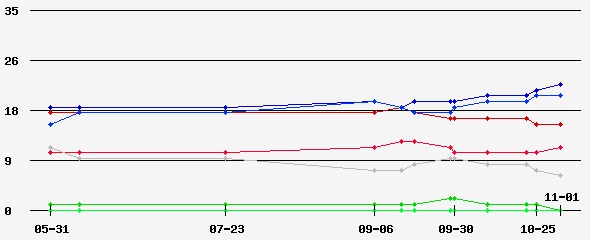





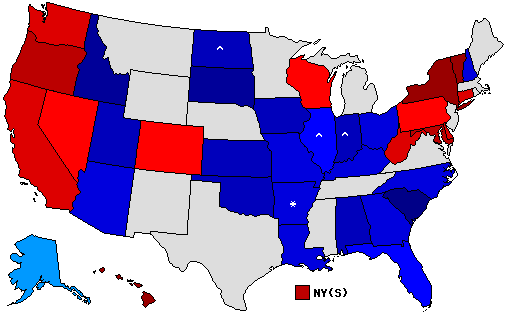
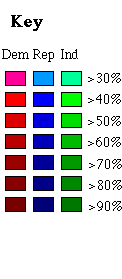
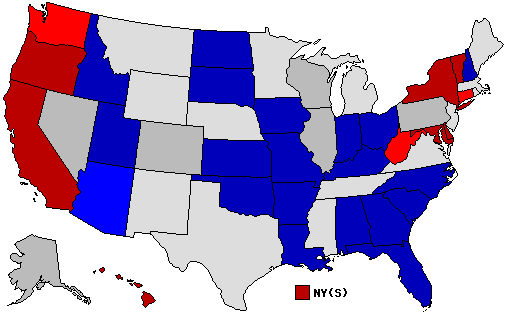
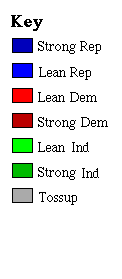
 2020 President
2020 President 2020 Senate
2020 Senate 2016 President
2016 President 2016 Senate
2016 Senate 2014 Senate
2014 Senate 2012 President
2012 President 2012 Senate
2012 Senate 2010 Senate
2010 Senate 2010 Governor
2010 Governor 2008 President
2008 President 2008 Senate
2008 Senate 2008 Governor
2008 Governor 2006 U.S. Senate
2006 U.S. Senate 2006 Governor
2006 Governor

